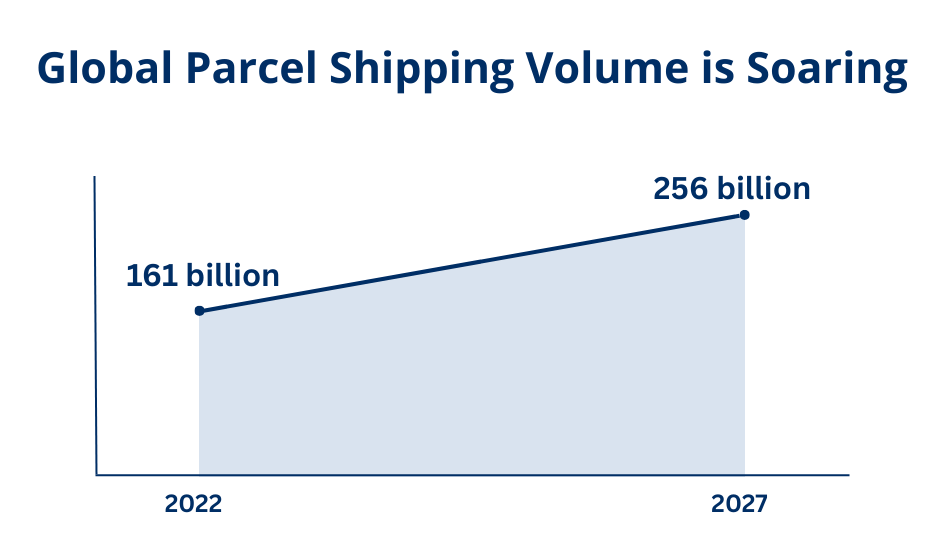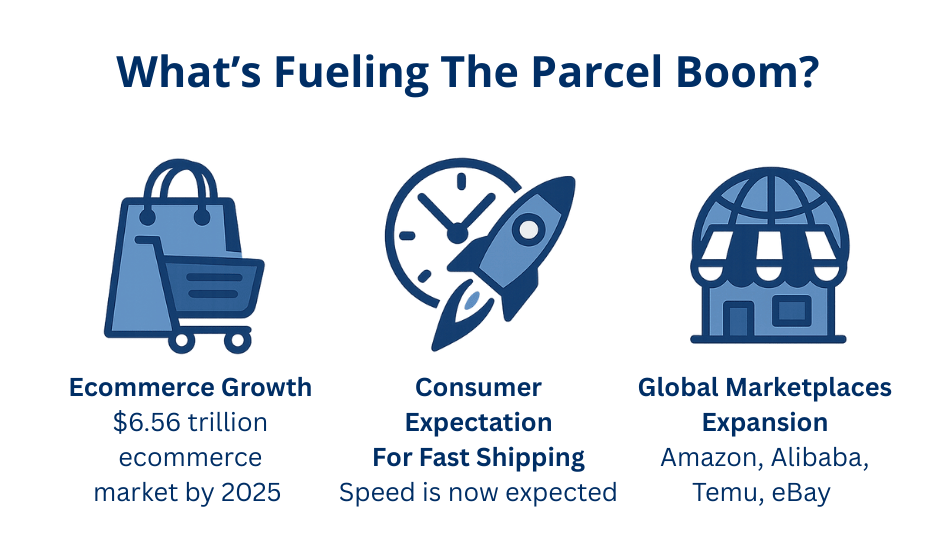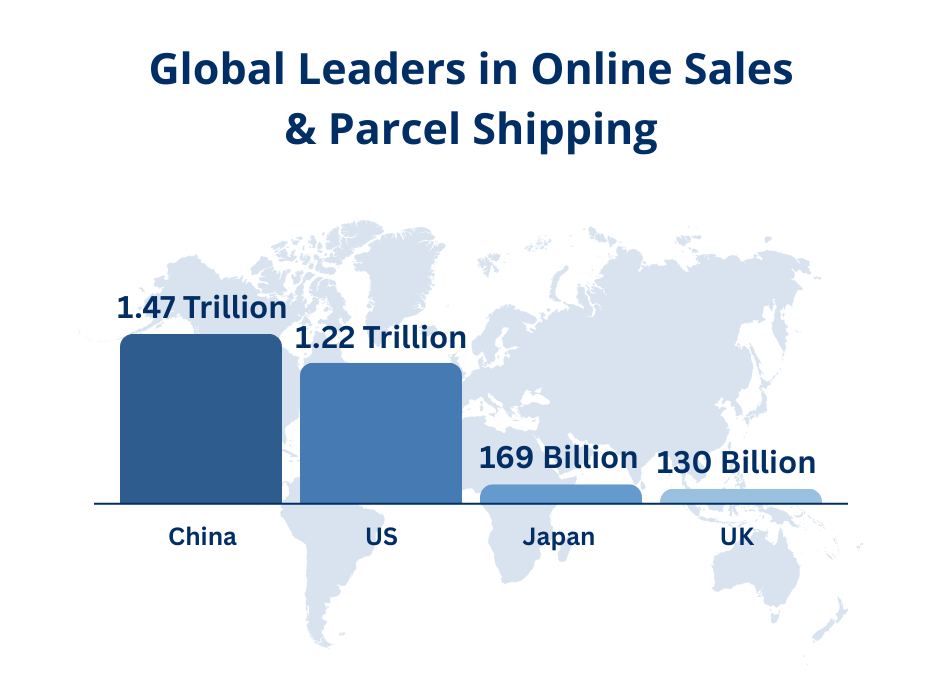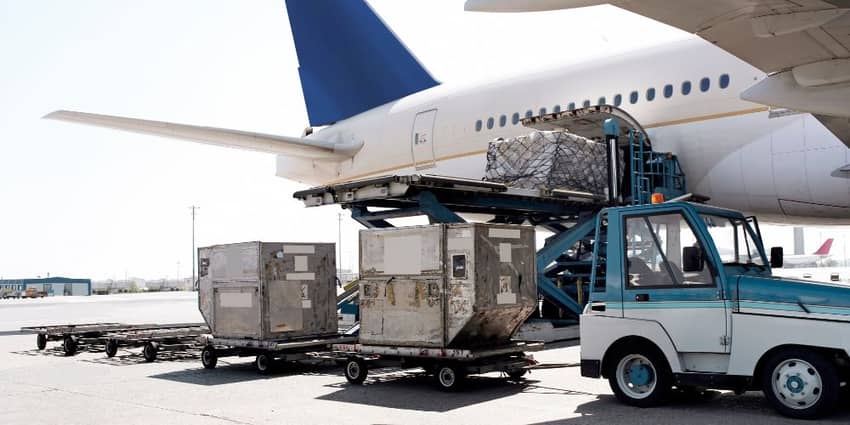Cite this article: Interparcel. (2025, April 28). How Many Parcels Are Shipped Worldwide? And Why The Numbers Keep Exploding. https://au.interparcel.com/blog/news/how-many-parcels-are-shipped-worldwide
Report Highlights:
- In 2022 alone, over 161 billion parcels were shipped globally, 20 times the global population. By 2027, that number is expected to hit 256 billion.
- The rise of global marketplaces, mobile shopping, and faster delivery expectations are fueling record-breaking shipping volumes year after year.
- Next-day and same-day delivery have become the norm, pushing retailers to rethink fulfilment and shipping strategies.
- China, the U.S., Japan, and the U.K. lead in parcel volume, but Southeast Asia and Latin America are the fastest-growing regions.
- Businesses are turning to multi-carrier shipping platforms to automate fulfilment, simplify courier management, and scale more efficiently.
The world of parcel delivery has been booming over the past couple of years.
Every day, it seems there’s another box on our doorstep, another delivery van on our street, and another warehouse popping up around the corner.
You might’ve even wondered: How many parcels are sent worldwide? And what’s driving all this growth?
In this article, we’ve collected the data to explore just how significant global parcel volumes have become, why they’re exploding, and what it all means for retailers out there.
Global Parcel Shipping Volume Overview
Parcel shipping has shifted from something occasional to a central part of everyday life.
The explosion of ecommerce, fueled by convenience and consumer demand, has turned parcel shipping into a cornerstone of the modern economy. But just how much shipping are we talking about?
It’s staggering. And it’s only getting bigger.
Parcel volumes have been surging for years, largely thanks to the skyrocketing growth of online shopping. Think about it, every click of a “Buy Now” button triggers a chain reaction of logistics, sorting, and transportation. All to deliver a package to someone’s doorstep, often within days, if not hours. And this chain reaction is happening billions of times each year.
The numbers speak for themselves…
According to data from Statista, global parcel shipping volume reached over 161 billion parcels in 2022.
Let that sink in for a second.
That’s more parcels than there are people on Earth, by a factor of 20.
And to top it off, projections suggest this volume will soar to 256 billion parcels by 2027.

Factors Driving the Increase in Parcel Shipments
So what’s driving this relentless growth? Two words: ecommerce expansion.
With platforms like Amazon, Shopify, and BigCommerce making it easier than ever for businesses to reach global customers, the demand for shipping services has exploded.
This trend shows no signs of slowing down. If anything, it’s speeding up. Let's look at why:
1. Surge in Online Shopping Habits
It’s hard to overstate just how much ecommerce has reshaped the parcel shipping landscape. With more retailers moving online and consumers growing increasingly comfortable with digital shopping, parcel volumes have gone through the roof.
Online shopping has transformed from a novelty to a necessity. Consumers expect to be able to order practically anything, clothes, groceries, furniture, electronics, from their couch. And businesses are scrambling to meet those expectations with lightning-fast shipping options.
According to Shopify’s Ecommerce Report, Shopify’s Ecommerce Report, are projected to reach $6.56 trillion by the end of 2025, reflecting just how integral online shopping has become to everyday life.
2. Increased Consumer Expectation for Fast, Reliable Delivery
Speed. It’s everything now. Convenience isn’t just about online shopping; it’s about how quickly something shows up at your door. Consumers are no longer satisfied with waiting weeks for an order to arrive.
Take Amazon Prime, for example. Its promise of one-day or even same-day delivery has pushed other retailers to step up their game. Now, what was once considered premium service has become the baseline expectation.
Offering faster delivery options doesn’t just satisfy customers, it creates an expectation that’s hard to shake. Once people get used to speedy shipping, anything less feels like a disappointment.
And as more companies offer expedited shipping, parcel volume continues to rise. The more parcels in transit, the more often consumers expect fast, reliable service. It’s a cycle that feeds itself.
3. Expansion of Global Marketplaces
Marketplaces like Amazon, Alibaba, Temu, and eBay aren’t just big players, they’re giants reshaping the landscape. And their reach is truly global. With merchants worldwide tapping into these platforms, the need for efficient, scalable parcel shipping has never been greater.
According to Nasdaq, Alibaba handled over 4 million international packages in the fiscal year ending March 31, 2023. And that’s just one company. When you factor in countless other ecommerce giants, the sheer scale of parcel shipping becomes even more mind-blowing.
The sheer scale of ecommerce marketplaces is a driving force behind the explosion in parcel shipping. And with every new merchant or customer they onboard, the numbers keep climbing.

Regional Breakdown: Who Ships the Most?
It’s not just about the sheer volume of parcels. Where these packages are coming from and heading to matters.
Different regions have different appetites for online shopping. And some countries are far more enthusiastic shippers than others. So, who’s leading the pack?
1. China
The undisputed global leader in ecommerce, China is home to giants like Alibaba (Taobao, Tmall), JD.com, Pinduoduo (Temu), and Shein. Its market dominance is driven by innovation, scale, and a thriving ecosystem of private label manufacturing. With annual online sales reaching $1.47 trillion, China consistently accounts for the top share of the world’s parcel shipping volume.
2. United States
The U.S. is a heavyweight in ecommerce and parcel shipping. With industry titans like Amazon, Walmart, Apple, and eBay, the U.S. sets global standards for fulfilment innovation, customer experience, and next-day delivery services. Its ecommerce market generated $1.22 trillion in annual online sales, contributing significantly to global parcel traffic.
3. Japan
Though individual spending per capita is lower than China or the U.S., Japan’s 125 million population fuels high shipping volumes. Rakuten leads the charge, with other major retailers like Yodobashi making strong contributions to domestic ecommerce growth. Japan recorded $169 billion in annual online sales, earning it a solid spot among the top shipping nations.
4. United Kingdom
The U.K. remains a dominant force in ecommerce relative to its size. With a large share of the population shopping online and major platforms like Amazon UK, eBay, and Asos, as well as strong supermarket ecommerce channels like Tesco and Sainsbury’s, the U.K. generated $130 billion in online sales. It also has one of the highest percentages of total retail sales coming from ecommerce, making it a key player in parcel shipping across Europe and beyond.

The Fastest-Growing Markets to Watch
While the top four countries dominate in parcel volume, they aren’t necessarily the ones growing the fastest. Developing markets, particularly in Southeast Asia and Latin America, are rapidly ramping up. As digital infrastructure improves and ecommerce platforms gain traction, parcel volumes in these areas are set to explode.
This growth is reshaping the global logistics map, creating new lanes, new customer expectations, and new opportunities for international sellers.
Challenges and Opportunities from Rising Parcel Volumes
Growth is great, until it becomes unmanageable. The sharp rise in parcel volumes brings a whole host of challenges. But with those challenges come some pretty enticing opportunities.
Environmental Considerations and Sustainability Pressures
According to the World Economic Forum, urban last-mile delivery emissions could increase by over 30% by 2030 if no action is taken to improve efficiency.
More packages mean more carbon emissions. And with eco-conscious consumers paying closer attention to their environmental footprint, businesses can’t afford to ignore sustainability.
Companies investing in green initiatives stand to earn more than just goodwill. These initiatives not only reduce your impact but also strengthen customer loyalty in the process.
Today’s consumers are actively choosing brands that align with their values. When they see you’re making an effort to reduce waste or cut emissions, it reinforces their decision to buy from you and come back again.
Inventory Management Is Under Pressure
As parcel volumes increase, so do the logistical challenges behind the scenes. Many businesses have started to feel the strain, jumping between courier websites, copying order details manually for shipments, and trying to stay on top of delivery issues while keeping customers happy.
That’s why more growing retailers are turning to multi-carrier shipping platforms.
These platforms act as a central hub, connecting your online store to a network of courier services, automating routine fulfilment tasks, and offering tools to help manage orders at scale with advanced shipping technology.
This allows you to compare quotes from multiple couriers without needing to set up individual accounts with each one.
Some platforms, like Interparcel, go a step further by offering instant access to discounted courier rates, branded tracking, and no lock-in contracts, making them ideal for small to mid-sized businesses who want flexibility and control.
As shipping becomes more complex, the right platform can turn rising volumes into a competitive edge.
Shipping Isn’t Slowing Down , It’s Evolving
Parcel shipping is no longer an occasional operation, it’s front and centre in how we shop, how we sell, and how we grow our economy.
From major markets like China and the U.S. to fast-rising players in Southeast Asia and Latin America, one thing is clear: the world is moving more parcels than ever before, and it’s only accelerating.
For retailers, this shift isn’t just about keeping up, it’s about adapting smartly. The brands that thrive in this new landscape are the ones that see shipping not as a cost but as a growth driver.
That means embracing smarter tools, streamlining fulfilment, and building shipping strategies that scale with demand.
Multi-carrier shipping platforms are quickly becoming essential to that strategy, helping businesses simplify operations, offer faster delivery, and stay competitive without compromising control or flexibility.
Because in a world where billions of parcels are moving every year, the question isn’t if you’ll need to evolve your shipping; it’s how fast you can.










 Facebook
Facebook Twitter
Twitter Instagram
Instagram Linked In
Linked In YouTube
YouTube